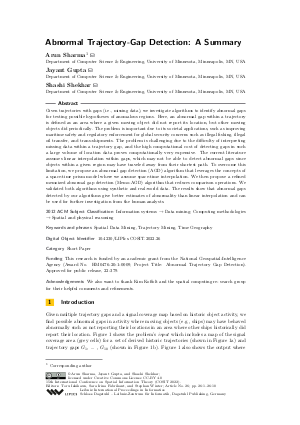@InProceedings{sharma_et_al:LIPIcs.COSIT.2022.26,
author = {Sharma, Arun and Gupta, Jayant and Shekhar, Shashi},
title = {{Abnormal Trajectory-Gap Detection: A Summary}},
booktitle = {15th International Conference on Spatial Information Theory (COSIT 2022)},
pages = {26:1--26:10},
series = {Leibniz International Proceedings in Informatics (LIPIcs)},
ISBN = {978-3-95977-257-0},
ISSN = {1868-8969},
year = {2022},
volume = {240},
editor = {Ishikawa, Toru and Fabrikant, Sara Irina and Winter, Stephan},
publisher = {Schloss Dagstuhl -- Leibniz-Zentrum f{\"u}r Informatik},
address = {Dagstuhl, Germany},
URL = {https://drops.dagstuhl.de/entities/document/10.4230/LIPIcs.COSIT.2022.26},
URN = {urn:nbn:de:0030-drops-169115},
doi = {10.4230/LIPIcs.COSIT.2022.26},
annote = {Keywords: Spatial Data Mining, Trajectory Mining, Time Geography}
}

 Creative Commons Attribution 4.0 International license
Creative Commons Attribution 4.0 International license
















